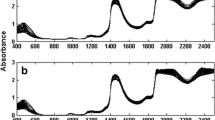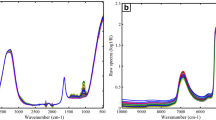Abstract
Phenolic compounds are biologically important molecules existed in many different plants and fruits. There is a need for a reliable analytical method possessing speedy monitoring, ease of operation, and simple instrumentation. We have developed a fast and reliable spectrophotometric method for simultaneous determination of p-hydroxybenzoic (PHBA), vanillic (VA), and caffeic (CA) acids in fruit juice samples. To overcome the severe spectral overlapping, partial least squares (PLS) regression as a multivariate calibration method was successfully developed for the simultaneous determination of PHBA, VA, and CA in ternary solutions. The experimental calibration matrix was designed with 25 ternary mixtures of these compounds, and the calibration models were validated with six synthetic mixtures. Calibration graphs were linear in the range of 0.0–6.0, 0.0–12.0, and 0.0–12.0 μg mL−1; limit of detections (LODs) were found to be 0.092, 0.1 l7, and 0.107 μg mL−1 for PHBA, VA, and CA, respectively. The root-mean-square errors of prediction (RMSEPs) for the same order of target compounds were 0.084, 0.146, and 0.114. The accuracy of the method was confirmed with the recoveries ranging between 84 and 107 %. The relative standard deviations (RSDs) for the analytes in the analysis of fruit juice samples were lower than 4 %. The PLS results were found to be in good agreement with those obtained by high-performance liquid chromatography-ultraviolet detection (HPLC-UV) method. Such a chemometrics-based protocol may be a promising tool for more analytical applications in real sample monitoring, due to its advantages of simplicity, rapidity, and accuracy.




Similar content being viewed by others
References
Abad-Garcia B, Berrueta LA, Lopez-Marquez DM, Crespo-Ferrer I, Gallo B, Vicente F (2007) Optimization and validation of a methodology based on solvent extraction and liquid chromatography for the simultaneous determination of several polyphenolic families in fruit juices. J Chromatogr A 1154:87–96
Capron X, Smeyers-Verbeke J, Massart DL (2007) Multivariate determination of the geographical origin of wines from four different countries. Food Chem 101:1585–1597
Carrasco-Pancorbo A, Cifuentes A, Cortacero-Ramirez S, Segura-Carretero A, Fernandez-Gutierrez A (2007) Coelectroosmotic capillary electrophoresis of phenolic acids and derivatized amino acids using N,N-dimethylacrylamide-ethylpyrrolidine methacrylate physically coated capillaries. Talanta 71:397–405
Gao JF, Wang JH, Yang C, Wang SY, Peng YZ (2011) Binary biosorption of Acid Red 14 and Reactive Red 15 onto acid treated okara: simultaneous spectrophotometric determination of two dyes using partial least squares regression. Chem Eng J 171:967–975
Gerlach RW, Kowalski BR, Wold HO (1979) Partial least-squares path modelling with latent variables. Anal Chim Acta 112:417–421
Ghasemi JB, Zolfonoun E (2010) Simultaneous spectrophotometric determination of trace amounts of uranium, thorium, and zirconium using the partial least squares method after their preconcentration by α-benzoin oxime modified Amberlite XAD-2000 resin. Talanta 80:1191–1197
Halliwell B (2007) Dietary polyphenols: good, bad, or indifferent for your health? Cardiovasc Res 73:341–347
Helmja K, Vaher M, Puessa T, Kamsol K, Orav A, Kaijurand M (2007) Bioactive components of the hop strobilus: comparison of different extraction methods by capillary electrophoretic and chromatographic method. J Chromatogr A 1155:222–229
Huang HY, Lien WC, Chiu CW (2005) Comparison of microemulsion electrokinetic chromatography and micellar electrokinetic chromatography methods for the analysis of phenolic compounds. J Sep Sci 28:973–981
Jolliffe I (1986) Principal components in regression analysis. In: principal component analysis. Springer, pp. 129–155
Kasai H, Fukada S, Yamaizumi Z, Sugie S, Mori H (2000) Action of chlorogenic acid in vegetables and fruits as an inhibitor of 8-hydroxydeoxyguanosine formation in vitro and in a rat carcinogenesis model. Food Chem Toxicol 38:467–471
Khani R, Ghasemi JB, Shemirani F (2014) Simultaneous multicomponent spectrophotometric monitoring of methyl and propyl parabens using multivariate statistical methods after their preconcentration by robust ionic liquid-based dispersive liquid–liquid microextraction. Spectrochim Acta A 122:295–303
Klejdus B, Vacek J, Lojkova L, Benesova L, Kuban V (2008) Ultrahigh-pressure liquid chromatography of isoflavones and phenolic acids on different stationary phases. J Chromatogr A 1195:52–59
Kupeli E, Sahin FP, Calis I, Yesilada E, Ezer N (2007) Phenolic compounds of Sideritis ozturkii and their in vivo anti-inflammatory and antinociceptive activities. J Ethnopharmacol 112:356–360
Le Moigne M, Dufour E, Bertrand D, Maury C, Seraphin D, Jourjon F (2008) Front face fluorescence spectroscopy and visible spectroscopy coupled with chemometrics have the potential to characterise ripening of Cabernet Franc grapes. Anal Chim Acta 621:8–18
Makris DP, Kallithraka S, Mamalos A (2006) Differentiation of young red wines based on cultivar and geographical origin with application of chemometrics of principal polyphenolic constituents. Talanta 70:1143–1152
Manach C, Scalbert A, Morand C, Rémésy C, Jiménez L (2004) Polyphenols: food sources and bioavailability. Am J Clin Nutr 79:727–747
Miller JN, Miller JC (2000) Statistics and chemometrics for analytical chemistry, 4th edn. Pearson Education Limited, London
Otto M, Wegscheider W (1985) Spectrophotometric multicomponent analysis applied to trace metal determinations. Anal Chem 57:63–69
Perkampus HH, Grinter HC, Threlfall T (1992) UV–vis spectroscopy and its applications. Springer, New York
Pomponio R, Gotti R, Hudaib M, Cavrini V (2002) Analysis of phenolic acids by micellar electrokinetic chromatography: application to Echinacea purpurea plant extracts. J Chromatogr A 945:239–247
Proestos C, Kapsokefalou M, Komaitis M (2008) Analysis of naturally occurring phenolic compounds in aromatic plants by RP-HPLC and GC-MS after silylation. J Food Qual 31:402–414
Robbins RJ (2003) Phenolic acids in foods: an overview of analytical methodology. J Agric Food Chem 51:2866–2887
Rodriguez Vaquero MJ, Alberto MR, Manca de Nadra MC (2007) Antibacterial effect of phenolic compounds from different wines. Food Control 18:93–101
Saraji M, Mousavi F (2010) Use of hollow fibre-based liquid–liquid–liquid microextraction and high-performance liquid chromatography–diode array detection for the determination of phenolic acids in fruit juices. Food Chem 123:1310–1317
Saraji M, Mousavinia F (2006) Single-drop microextraction followed by in-syringe derivatization and gas chromatography–mass spectrometric detection for determination of organic acids in fruits and fruit juices. J Sep Sci 29:1223–1229
Schieber A, Keller P, Carle R (2001) Determination of phenolic acids and flavonoids of apple and pear by high-performance liquid chromatography. J Chromatogr A 910:265–273
Seeram NP, Lee R, Scheuller HS, Heber D (2006) Identification of phenolic compounds in strawberries by liquid chromatography electrospray ionization mass spectroscopy. Food Chem 97:1–11
Shui G, Leong LP (2002) Separation and determination of organic acids and phenolic compounds in fruit juices and drinks by high-performance liquid chromatography. J Chromatogr A 977:89–96
Sterbova D, Vlcek J, Kuban V (2006) Capillary zone electrophoretic determination of phenolic compounds in chess (Bromus inermis L.) plant extract. J Sep Sci 29:308–313
Villiers A, Majek P, Lynen F, Crouch A, Lauer H, Sandra P (2005) Classification of South African red and white wines according to grape variety based on the non-coloured phenolic content. Eur Food Res Technol 221:520–528
Vinson JA, Su XH, Zubik L, Bose P (2001) Phenol antioxidant quantity and quality in foods: fruits. J Agric Food Chem 49:5315–5321
Wold S, Esbensen K, Geladi P (1987) Principal component analysis. Chemom Intell Lab Syst 2:37–52
Zadernowski R, Czaplicki S, Naczk M (2009) Phenolic acid profiles of mangosteen fruits (Garcinia mangostana). Food Chem 112:685–689
Acknowledgments
The authors are grateful for the financial support of this work from the Research Council of University of Birjand.
Conflict of Interest
Rouhollah Khani declares that he has no conflict of interest. Reza Rahmanian declares that he has no conflict of interest. Naser Valipour Motlagh declares that he has no conflict of interest. This article does not contain any studies with human participants or animals performed by any of the authors.
Informed Consent
Informed consent was obtained from all individual participants included in the study.
Author information
Authors and Affiliations
Corresponding author
Rights and permissions
About this article
Cite this article
Khani, R., Rahmanian, R. & Motlagh, N.V. UV–Visible Spectrometry and Multivariate Calibration as a Rapid and Reliable Tool for Simultaneous Quantification of Ternary Mixture of Phenolic Acids in Fruit Juice Samples. Food Anal. Methods 9, 1112–1119 (2016). https://doi.org/10.1007/s12161-015-0287-3
Received:
Accepted:
Published:
Issue Date:
DOI: https://doi.org/10.1007/s12161-015-0287-3




